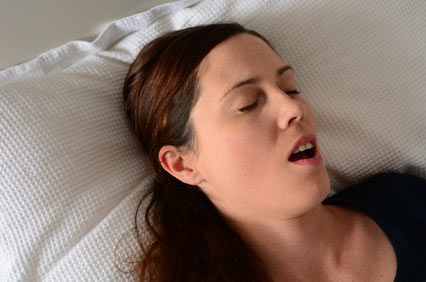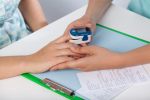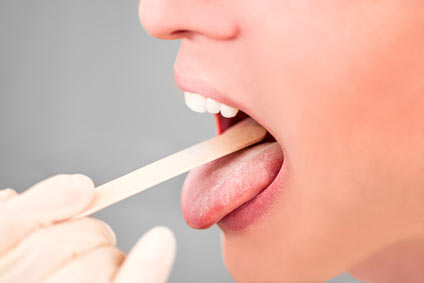What is Sleep Apnea?
Sleep Apnea Definition, Video Examples, Related Terms

Sleep apnea is a condition in which breathing temporarily stops during sleep.
The pause in breathing may take 10 seconds, or more.
There are cases where breathing stops for more than 60 seconds during sleep, as you will see in one of the following videos.
People with sleep apnea complain about:
- excessive sleepiness during the day,
- falling asleep while driving,
- headaches,
- heart problems,
- depression
- and stroke.
Types of Sleep Breathing Disorders
- Obstructive Sleep Apnea
(OSA) - this is the most common sleep related breathing disorder. The
tongue or other soft tissue from the back of the throat relaxes during
sleep blocking the airway.
- Central Sleep Apnea
(CSA) - the breathing stops without having any obstruction in the
airways. The brain "forgets" to tell the breathing muscle to move, thus
the person stops breathing for several seconds until he or she wakes up
and starts breathing again.
- Mixed or Complex Sleep Apnea. - there are brief periods of central apnea followed by longer periods of obstructive apnea.
- Upper Airway Resistance Syndrome (UARS) - your body awakes before you stop breathing in sleep completely. UARS is more common that expected, because it's very difficult to diagnose with only a standard polysomnogram.
Videos About Obstructive Sleep Apnea
To understand better what is sleep apnea and how you can stop breathing in sleep, please watch this video:
Many people with sleep apnea don't believe they have a sleep problem, and the only way to convince them to see a doctor is to video-record their sleep.
Check the following videos where the partner records the spouse:
 Getting Recorded With Obstructive Sleep Apnea:
Getting Recorded With Obstructive Sleep Apnea:
These videos make me take a deep breath at the end... As you can see, this is more than snoring. However, from simple snoring to obstructive apnea is only a couple of millimeters distance.
Many people with mild sleep apnea often have only a shallow breathing, called hypopnea. They should not ignore this symptom because it will worsen over time, with serious effects on their health and quality of life.
Now, the ultimatum proof. This can be scary to watch, but the description from this video will help you understand what is sleep apnea & how to recognize it:
How to Recognize the Symptoms of Sleep Apnea
1. During the Night:
Normal Breathing in Sleep vs Obstructive Sleep Apnea
Normal Breathing
|
OSA |
|
|
Snoring occurs when the airway is slightly narrowed. In other words, when you snore the airway is now smaller but still open.
However, complete blockage of the airway during sleep, or obstructive sleep apnea, has serious side effects on persons's health and quality of life.
For more info on side effects, see sleep apnea side effects.
2. During Daytime
A typical sleep apnea symptom is extreme fatigue. Because the breathing problem cause you to wake up several times a night, you can suffer terribly from sleep deprivation.
Excessive sleepiness can result in serious traffic and job accidents, and car accidents is one of the most common risk of death in patients with sleep apnea.
A person may feel extreme fatigue during the day from other health problems, not necessarily sleep apnea.
Discover the most common causes of extreme fatigue here.
Fatigue vs Sleepiness
Although you may think that fatigue and sleepiness are almost the same thing, you will discover a big difference in severe cases of extreme fatigue, such as chronic fatigue syndrome.
Additional Signs of Sleep Apnea
Other signs of sleep apnea are:
- morning headaches,
- easily irritated or annoyed,
- memory difficulties and problems with concentration,
- depression,
- impotence or loss of sex drive,
- anxiety.
For more details about signs and symptoms, see symptoms of sleep apnea.
Causes of Sleep Apnea
The most common risk factors for obstructive sleep apnea are:
- obesity - More than 60% of sleep apnea patients are overweight, so it should ring a bell to anyone who has body fat. However, it is not the excess of the weight that triggers sleep apnea, but the neck size that counts. Here are the facts: men with a neck circumference of 17 inches or larger,women with a neck circumference of 16 inches or larger,people with double chins,people with a lot of fat at the waist,are more likely to have their airway collapse while they sleep.
- age and gender - sleep apnea is often encountered in middle age and older adults, and more likely to strike men than women.
- genetic link - relatives of those affected with sleep apnea tend to be more likely to have apnea and shallow breathing.
- alcohol consumption - alcohol relaxes the muscles from the back of the throat leading to increasing risk for partial or complete obstruction of the airway.
- smoking - increases the risk for moderate to severe OSA, although the exact mechanism is not well understood. Scientists discovered that nicotine causes inflammation in the throat and reduces the upper airway muscle tone.
For complete info about causes and risk factors, see Causes of sleep apnea.
Sleep Apnea Treatment
Below you can find all the treatments that can help with your sleep apnea:
Talking with your doctor about your symptoms
It's in your best interest to speak with your doctor about your symptoms. And let me explain you why:
- it's difficult to diagnose sleep apnea just looking at someone. That's why your doctor may suggest that you spend a night in a sleep laboratory for a sleep study.
- the lab staff will use a polysomnogram, to test your sleep quality.
- the sleep technician will also measure the amount of oxygen your blood is carrying through your body, which shows how much oxygen you inhale during sleep. The less oxygen in the blood, the more severe sleep apnea is likely to be.
- once you know that you have sleep apnea and doctors have determined its severity, your doctor can decide the most appropriate treatment.







